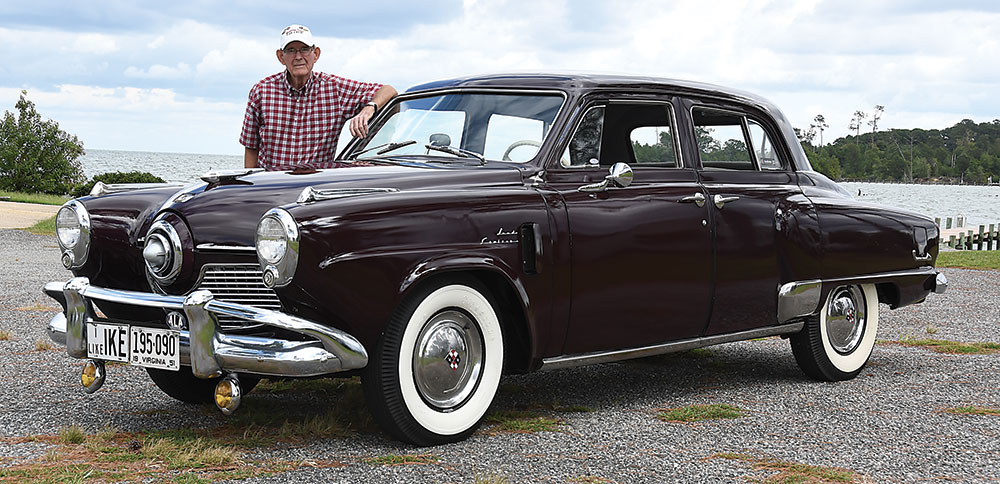
by Tom Chillemi –
Wings, Wheels and Keels set for Saturday
There was a time when automobiles had names evoking strength, durability and stamina. The “Commander State Land Cruiser” was Studebaker’s top of the line car in 1950-51.
The Memory Lane Car Club has chosen the 1951 Studebaker Land Cruiser owned by Ken Kidwell of Deltaville to be the featured vehicle for the 24th Wings, Wheels & Keels to be held Saturday, September 28, at Hummel Airfield in Topping.
There is no missing the unique futuristic styling of the Land Cruiser. Its “bullet nose” hood gave the look of an airplane. The front and rear were similar leading many to comment “is the car coming or going.”
“There were only two makes of cars, Studebaker and that other junk on the road.”
—Lester Kidwell
At the beginning of the “jet age,” car styling mimicked airplanes with tail fins that got bigger through the 1950s, culminating with the 1959 Cadillac whose tail fins points are 48 inches off the ground.
Studebaker’s radical design started in 1950 and lasted only two model years. Some senior officials at Studebaker thought the Land Cruiser’s styling would lead to bankruptcy, said Kidwell. But they changed their tune with the record-setting unit production.
Farmers did not like the ornate styling, said Kidwell. Today, the bullet nose center piece is being bought as “art.”
Studebaker’s forward thinking styling would later produce the Avanti “personal sized” car in 1962, with a fiberglass body and features not seen before. It was short-lived, however, Studebaker closed its factory in December 1963.
A decade earlier
In 1951 Studebaker built the most cars in its history. The Land Cruiser had an “extra long” 124-inch wheel base, giving rear passengers plenty of leg room. It’s smooth ride was softened by coil springs, rubber bushing and big balloon tires.
The manual transmission featured “Hill Holder.” When preparing to take off on a hill, the driver kept the clutch depressed to keep the car from rolling. This left the right foot ready to work the throttle. (In 1980 Subaru introduced its “Hill Holder,” using the same name, as Studebaker.)
In the family
Kidwell’s Land Cruiser, one of 38,055 built in 1951, has 39,000 actual miles and is in excellent mechanical condition. He acquired it from his late brother’s estate. “My brother and I learned to drive on this model Studebaker,” he said. “It wears one of the original license plates bought by our dad in 1951.”
The second identical plate was recreated by a Florida company that duplicates old plates. The “I Like Ike” plate was his brother’s idea. “Our father had a clear vision of automobiles,” said Kidwell. “In his view, there were only two makes of cars, Studebaker and that other junk on the road.” Kidwell’s father owned Studebakers as far back as he can remember. “He would not consider owning another make.”
Several decades ago Kidwell’s brother Don started looking for a duplicate of his dad’s car and found this Land Cruiser in Maryland. It became part of his collections before being transferred to Kidwell in 2016, so that it remains in the Kidwell family.
At that time Kidwell had 11 frame-off cars, mostly Studebakers, ranging from 1935 to 1963.
Kidwell was a “frame off” restorer, who removed the body from the frame to restore the vehicle so it looks and performs better than it did originally from the factory. “Original workmanship was not as perfected, durable and safe as today,” he explained.
Kidwell has had 11 Studebakers and has spent thousands of hours in his garage working on them. “I lose track of time and everything,” he said. “This is therapy.”
Kidwell’s brother was a “preservation restorer.” A “preservation class” resoration is not as detailed or as laborious as a frame-off restoration. Kidwell’s Land Cruiser has been repainted and a new original-style upholstery kit was installed. The car is relatively rust free in spite of the acknowledged fact that Studebakers are rust prone.
Special features
Options were limited in those days when a buyer only got a “cigar lighter” in the standard edition, said Kidwell. A buyer could upgrade the interior, transmission, hub caps, trim, and dealer-installed items without buying a “package” of stuff they did not need or want.
Kidwell’s Land Cruiser cost $2,071 in 1951, which is about $21,000 in today’s money. It weighs 3,070 pounds, about 500 pounds less than a Toyota Camry.
It was powered by a revolutionary 233-cubic-inch overhead valve V-8 engine that got 28 miles per gallon—better than many 6 cylinder engines of the day. It was the first V-8 engine to be offered in a non-luxury car. With 7 to 1 compression, it cranked out 120 horsepower at 4,000 RPM. It achieved a record 28 MPG with its overdrive transmission, and that brought forward the Studebaker slogan “Studebaker is the thrifty one for 51.”
“Some believe this engine was the start of high-performance capacity,” said Kidwell. The engine was built by Studebaker. Ford and Chevrolet would not have an overhead valve V-8 until 1954.
The doors open by pulling the handles, instead of turning them down. Pull handles are standard on vehicles today.
From wagons to cars
The Studebaker family emigrated to the United States in the late 1700s. It’s widely held that Studebaker was America’s oldest “vehicle” maker. Three brothers with blacksmith and carpenter backgrounds formed Studebaker corporation in 1852 and started making all sorts of vehicles including, but not limited to, wheelbarrows, farm vehicles and Conestoga-type wagons used extensively to settle the West and during the Civil War.
That family is still in the United States, including a member in close proximity to Deltaville, said Kidwell. “She came to a local show about 10 years ago that had two of my cars on display. She told me about her family connection and history to Studebaker, including an interesting legal fight her ancestors instituted to preserve the Studebaker name for married females. At that time women could not vote and when married they had to assume the husband’s last name. They won and to this day they control the Studebaker name.”



